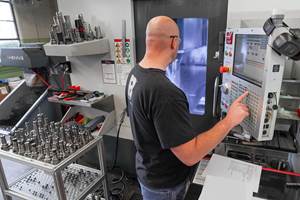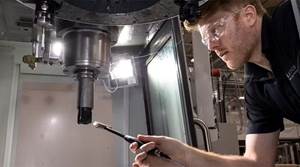Making A Flexible Machine Tool More Flexible
Multitasking cutting tools can maximize the flexibility of multitasking machines.
Share






Anyone with the resources and the inclination can buy a machine tool. But not everyone can wring out the same amount of production from the same machine. Multitasking machines loaded with multiple turrets and/or spindles offer a great deal of production potential, as they can often completely machine a part on its own. Granted, these machines are more costly than their straightforward lathe and milling machine brethren. However, it's clear that shops battling just-in-time delivery schedules and shrinking batch sizes recognize the money-making potential of such machines, as their sales increase every year. It's the classic case of biting the bullet and choosing equipment that initially is more expensive, but offers greater payback down the road.
But the multitasking machine can't do it alone. The choices made in combining various machining elements and strategies into an efficient process ultimately separate the great shops from the average Joes. CAM programming continues to be a challenge for multitasking machines, which isn't surprising considering it involves simultaneous machining operations and orchestrated movement of a number of machine components.
Tooling can also play a make-or-break role. It's logical to think that a multitasking machine designed with flexibility in mind would use tooling that was also flexible. Such tooling would provide the capability to perform a variety of different machining operations with just one tool. A universal spindle interface that can accommodate both turning and milling operations can also augment process versatility. There are a few reasons for this.
First, space can be saved—turret space, to be more specific. The multiple turrets and spindles located within a multitasking machine not only limit space within the machining zone, but also place limits on tool magazine capacity. A single tool that offers five different cutting operations, for example, could free up four tool pockets. Those extra pockets could then be used to hold different tools for parts that require many machining operations or sister tooling to allow extended, unattended operation.
Second, cycle times can be quicker through the elimination of non-value-adding tool change time. A multitasking tool might just require spindle indexing to bring a different turning insert into position, for example.
Third, a universal, modular spindle interface that is effective for milling, turning and drilling operations allows for one common tooling platform for the shop's entire operation. This concept of standardization falls in line with the strategies of lean manufacturing.
During a recent visit to its international headquarters in Sandviken, Sweden, Sandvik Coromant (Fair Lawn, New Jersey) demonstrated the value that a multitasking tool platform, such as its Coroplex line, can provide for multitasking machines. The visit included a tour through the production facility for its mining and construction division, which heeds the advice of its sister tooling company by using robot-tended cells that combine multitasking machines with multitasking tools to produce various mining drill bit components (see sidebar on page 77).
Tooling Versatility
There are a few different approaches in terms of multitasking tool design. One is the combination of turning and milling inserts on a single tool body. That one tool could perform shoulder milling, turn-milling or circular interpolation, for example, as well as face and longitudinal turning, profiling or internal turning. To combine turning and milling capability on one tool requires a design in which the turning inserts don't contact the workpiece while the tool is milling. To avoid this, the milling inserts are located just ahead of the turning inserts axially and radially so that the turning inserts are not in cut when the tool is milling.
Another technique combines two turning inserts located on opposite sides of a tool body. The tool can perform a rough turning operation, then be indexed 180 degrees in the spindle to allow finish turning.
Yet another concept uses a modular mini-turret unit that can combine four different cutting modules to allow four turning operations on one tool. This would enable a single tool to rough turn, finish turn, cut a groove and turn a thread, for example. The combination of cutting modules is user-selectable, and it would depend on the type of part and the required machining operations.
Maintaining tool center line accuracy is especially important for multitasking machines to make sure that the tool is precisely positioned to perform a turning operation. This is where it is helpful to have a modular, universal spindle/tool interface. Such an interface is effective for multitasking machines, as their spindle(s) could be called on to mill or lock into position for a turning operation.
Programming And Tooling
One of the issues that tooling companies sometimes face when introducing new tool designs is the lag in terms of CAM software support of new tools. Often, though, programming is not made more difficult because of the new tool. To change from a milling operation to a turning operation for tools that can perform both just requires the spindle to precisely index to bring the turning insert is in proper position. There's no programming difference if that tool is used for milling, as the tool essentially is a milling cutter that happens to have turning inserts on board.
Related Content
Briquetting Manufacturer Tools Up for Faster Turnaround Times
To cut out laborious manual processes like hand-grinding, this briquette manufacturer revamped its machining and cutting tool arsenal for faster production.
Read MoreMedical Shop Performs Lights-Out Production in Five-Axes
Moving to five-axis machining enabled this shop to dramatically reduce setup time and increase lights-out capacity, but success relied on the right combination of workholding and automation.
Read MoreShop Reclaims 10,000 Square Feet with Inventory Management System
Intech Athens’ inventory management system, which includes vertical lift modules from Kardex Remstar and tool management software from ZOLLER, has saved the company time, space and money.
Read MoreHow to Mitigate Chatter to Boost Machining Rates
There are usually better solutions to chatter than just reducing the feed rate. Through vibration analysis, the chatter problem can be solved, enabling much higher metal removal rates, better quality and longer tool life.
Read MoreRead Next
AMRs Are Moving Into Manufacturing: 4 Considerations for Implementation
AMRs can provide a flexible, easy-to-use automation platform so long as manufacturers choose a suitable task and prepare their facilities.
Read MoreMachine Shop MBA
Making Chips and Modern Machine Shop are teaming up for a new podcast series called Machine Shop MBA—designed to help manufacturers measure their success against the industry’s best. Through the lens of the Top Shops benchmarking program, the series explores the KPIs that set high-performing shops apart, from machine utilization and first-pass yield to employee engagement and revenue per employee.
Read More




















